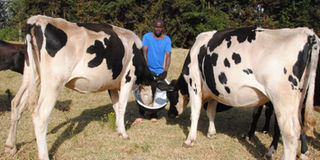VET ON CALL: When buying dairy cow, looks can be deceiving

Mr Matthew Kirui feeds his Fresian dairy cows in Elburgon, Nakuru County. PHOTO| JOHN NJOROGE | NATION
What you need to know:
- Farmers heap praise on the animals they are selling and provide very well-thought out excuses for flaws
It is always good for a buyer to know the reason someone is selling animals
The day was chilly, foggy and wet. George, a Nairobi farmer, his manager David and I were on a mission to buy five Friesian dairy cows.
We had arrived at Kiratina shopping centre in Lari Sub-County at 10am and found Mburu, my contact, sheltered at a tea-buying centre.
“Doctor, are you sure cattle from here will survive the Ruai heat?” David asked as we stopped to pick up Mburu.
I told him Friesian cows are adaptive. I once encountered Friesians doing well on farms that were not air-conditioned in the gruelling heat of Jordan.
Mburu directed us to Mwangi’s home. I had already given George and David lessons on selecting dairy cattle.
We, therefore, agreed the two would review the animals. We would compare notes and settle on the best.
Once the prices were agreed upon, based on the animals’ conditions, breeding, health and production history, I would examine the cows to confirm their suitability for milk production.
We also agreed my results would be the determinant of the final selling price. I use this protocol because there is no need to examine every cow offered for sale yet the transacting parties may not agree on the price.
Good candidates
The other reason is to save the buyer time and part of the doctor’s fees by only examining prequalified cattle candidates.
Like car dealers, farmers heap praise on the animals they are selling and provide very well-thought out excuses for flaws.
Some explanations are cunning while others are hilarious.
I recall a time a farmer told me he was selling all his livestock because his in-laws had developed a habit of demanding animals from him as bride price every time they visited. The visits increased as the heard grew!
“Pick any two from my herd of three,” Mwangi offered.
He said he wanted to sell the cows in order to pay school fees. He would restock later. That was fair enough. It is always good for a buyer to know the reason someone is selling animals.
Two of Mwangi’s cows were nice Friesians but the third had Sahiwal hips; meaning somewhere in the breeding, there had been some semen mix-up.
I agreed with Mwangi. His other two cows could easily produce the 25 litres he said they gave at peak lactation. George and David returned a rejection.
“Sorry Mwangi, your two good cows are not medically sound,” George said, adding that one was limping while the other had a swollen jaw.
Infection
Despite Mwangi’s defence of his assets, we never arrived at my examination because I had also noticed the flaws.
Mwangi said the jaw problem had started as a small abscess, which had been treated. When I palpated the jaw, the problem was more serious than Mwangi thought.
The cow had an attack of lumpy jaw disease. This is caused by a bacteria that hardens soft tissues and causes bone infection.
I advised Mwangi to request his doctor to review the cow. We proceeded to the next farm.
Monica’s farm was in Githunguri. It had a nice zero-grazing unit with three beautiful Friesians. The environment told of a previously well-stocked dairy farm.
Monica said she used to have 15 cows but was winding up dairy production to concentrate on other businesses.
Just like Mwangi, the farmer told us to choose any two cows. We knocked out one immediately because it had residual lumpy skin disease nodules. It takes long after the disease has healed for the nodules to disappear but it is not advisable to buy an unsightly cow.
Examination
George and David liked the other two and agreed on the price with Monica. I then examined the animals. One had no detectable flaw while the other had slight sub-clinical mastitis. I picked the problem with the California Mastitis Test.
The cow was three months pregnant. I informed George that he could still buy it though Monica needed to meet the cost of treatment. She agreed.
We had expected our last three animals to come from Kamau’s herd half a kilometre away but it remained just that — expectation.
First the seller gave us an impossibly high price. He had a good herd of 10 adult Friesians but their milk production fell short of the information given. The animals were not pregnant but the asking price was for pregnant ones.
To complicate matters, George was negotiating with the seller on phone and had to keep asking the farmhand to identify and display the animal being referred to.
After an hour of phone haggling and no deal, we were on the road to the last group of cattle.
Halfway through the route, we found three matatus stuck in mud at Kamuchege centre. There were also two four-wheel-drive vehicles ahead of us fighting a seemingly losing battle with the mud.
We decided it would not be possible to make it to the target farm about two kilometres ahead.
A dairy farmer had just lost a potential sale for three animals because of a poor road.
We closed the day by organising for transport documentation of the cows. Mobile phones are a blessing.
We got a “No Objection Permit” from Nairobi, which we presented to the Githunguri Vet office and were issued with a movement licence.





